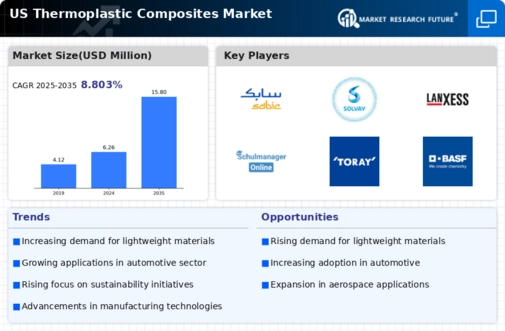The thermoplastic composites market is currently characterized by a dynamic competitive landscape, driven by increasing demand for lightweight materials across various industries, including automotive, aerospace, and consumer goods. Key players such as Toray Industries (Japan), SABIC (Saudi Arabia), and Hexcel Corporation (US) are strategically positioning themselves through innovation and partnerships. For instance, Toray Industries (Japan) focuses on enhancing its product portfolio with advanced materials that offer superior performance, while SABIC (Saudi Arabia) emphasizes sustainability in its manufacturing processes, aiming to reduce environmental impact. These strategies collectively contribute to a competitive environment that is increasingly focused on technological advancements and sustainability initiatives.
In terms of business tactics, companies are localizing manufacturing to reduce lead times and optimize supply chains. The market structure appears moderately fragmented, with several key players exerting influence over specific segments. This fragmentation allows for niche players to thrive, while larger corporations leverage their resources to establish a more significant market presence. The collective influence of these key players shapes the competitive dynamics, as they engage in strategic collaborations and investments to enhance their market positions.
In October 2025, Hexcel Corporation (US) announced a partnership with a leading aerospace manufacturer to develop next-generation thermoplastic composite materials. This collaboration is expected to accelerate the adoption of lightweight materials in aircraft design, thereby enhancing fuel efficiency and reducing emissions. The strategic importance of this partnership lies in its potential to position Hexcel as a leader in the aerospace sector, aligning with the industry's shift towards more sustainable practices.
In September 2025, SABIC (Saudi Arabia) launched a new line of thermoplastic composites designed specifically for automotive applications. This product line aims to meet the growing demand for lightweight materials that enhance vehicle performance and fuel efficiency. The introduction of this line underscores SABIC's commitment to innovation and its strategic focus on the automotive sector, which is increasingly prioritizing sustainability and performance.
In August 2025, Toray Industries (Japan) expanded its production capacity for thermoplastic composites in North America. This expansion is anticipated to meet the rising demand from various industries, particularly in the automotive and aerospace sectors. The strategic significance of this move lies in Toray's ability to enhance its supply chain efficiency and responsiveness to market needs, thereby solidifying its competitive position in the region.
As of November 2025, current competitive trends in the thermoplastic composites market include a strong emphasis on digitalization, sustainability, and the integration of artificial intelligence in manufacturing processes. Strategic alliances are increasingly shaping the landscape, as companies recognize the value of collaboration in driving innovation and enhancing operational efficiency. Looking ahead, competitive differentiation is likely to evolve from traditional price-based competition to a focus on innovation, technological advancements, and supply chain reliability. This shift suggests that companies that prioritize these aspects will be better positioned to thrive in an increasingly competitive market.


















Leave a Comment